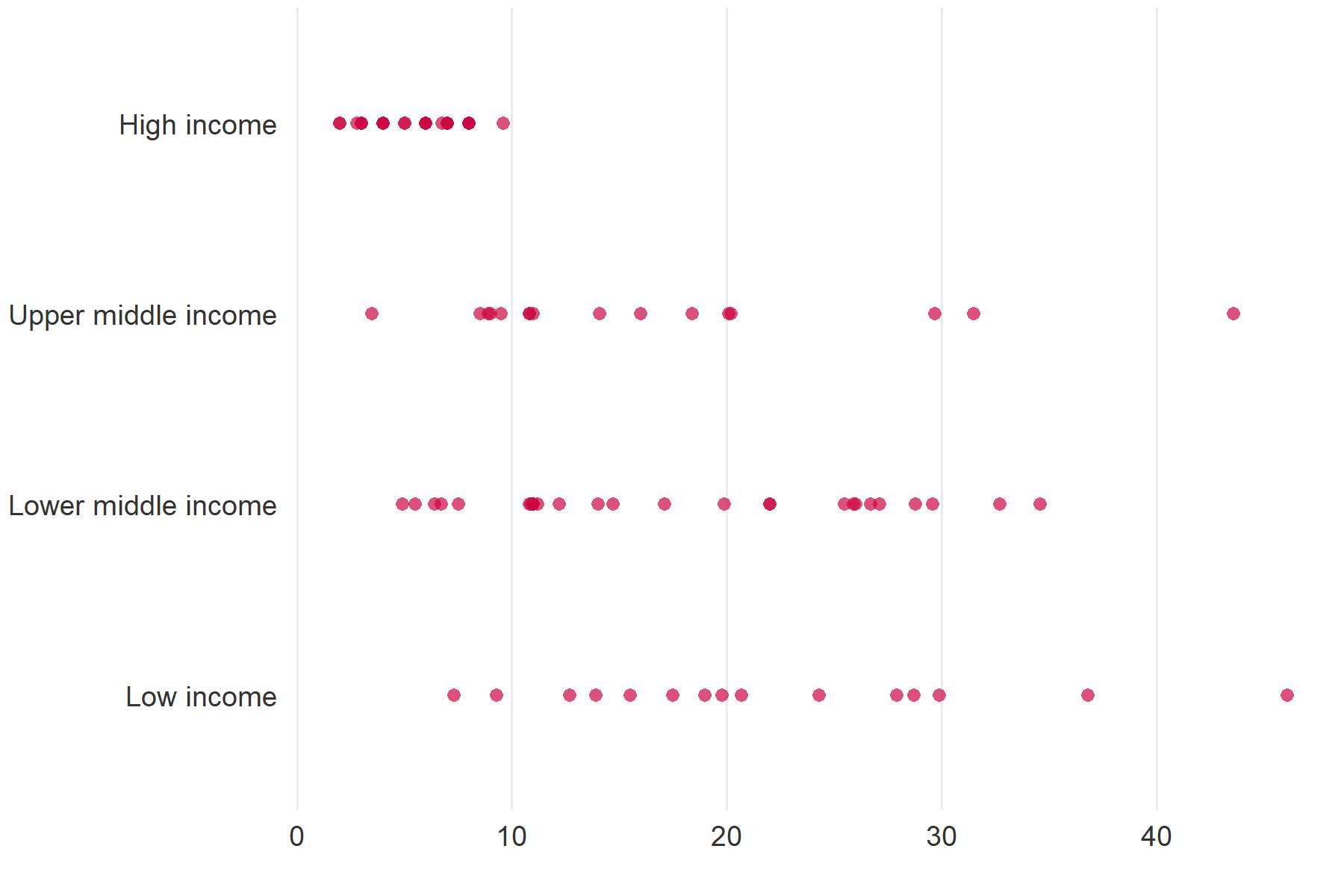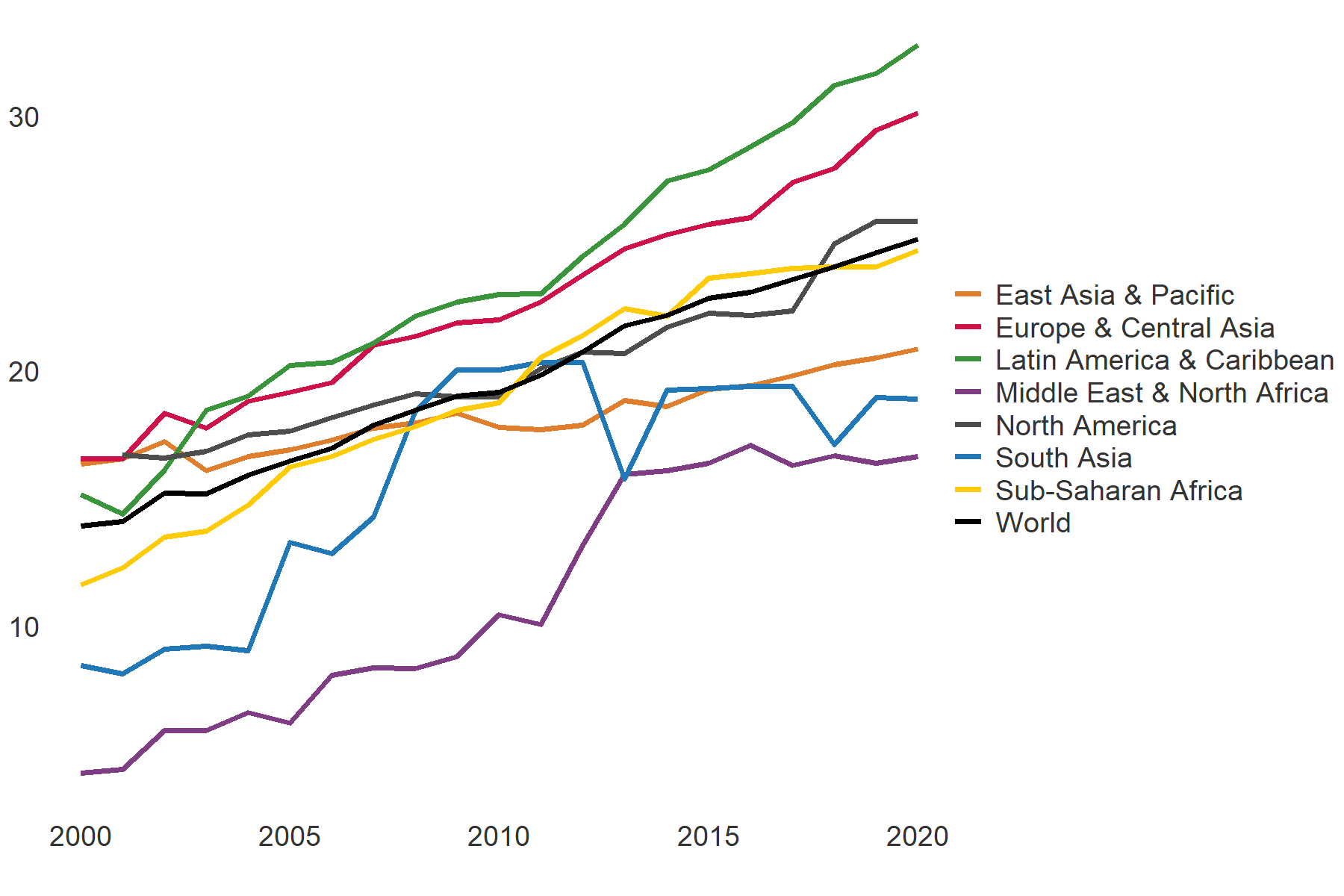


Gender equality
Legal progress towards gender equality
Providing equal rights to women and men is fundamental to achieving gender equality. For generations, women’s rights movements have fought to make this a reality. For example, while it was not the case a century ago, today most women around the world have the right to vote. But many other laws affecting economic opportunity and financial and social inclusion continue to treat men and women differently.
On a broad set of legal rights, the average woman today is afforded only three-quarters of the rights the average man enjoys. The World Bank's
The Women, Business and the Law explores 35 legal questions in all. The legal rights are divided among eight indicators across various themes (
Women, Business and the Law Index
WBL Index (0-100), 1970-2019
Source: Women, Business and the Law 2020
On average, laws related to Mobility and Entrepreneurship come closest to treating men and women equally, while those related to Parenthood—such as paid parental leave and prohibiting dismissal of pregnant workers—are the most unequal.
All regions have made progress in legislating for equal rights, but progress has come at different rates and reached different levels.
North America and Europe and Central Asia have come closest to providing equal rights to women and men, with overall scores of 96 and 90 respectively in 2019, marked improvements from 67 and 56 in 1970.
For example, in 1970 only two economies, both in Europe and Central Asia, had a law mandating equal remuneration for work of equal value. In 2019 it was the law in 38 of the region’s 49 economies.
Does the law mandate equal remuneration for work of equal value?
Source: Women, Business and the Law 2020
Also, in 1970 no economy had legislation specifically addressing domestic violence. Today, 155 of 190 economies do.
Is there legislation specifically addressing domestic violence?
Source: Women, Business and the Law 2020
Some regions have reformed more in certain indicators, while lagging on others. Latin America and the Caribbean has almost entirely reformed the Assets indicator governing property and inheritance, while South Asia lags with a score of 55 out of 100. But for Marriage, South Asia has improved by 33 percent from 52 to 70 between 1970 and 2019.
The Workplace has seen the most reform
Across all regions, progress has been the greatest for laws regulating the Workplace. In this analysis, an economy is considered fully reformed in an indicator if it has all the relevant good practice legislation; partially reformed if it has some but not all the good practice legislation; and not reformed if it has no good practice legislation. In 1970 no economy had implemented the full suite of legislative reforms in the Workplace. By 2019, 113 of 190 economies had.
Workplace
Source: Women, Business and the Law 2020
Explore each legal question related to the Workplace below.
Can a woman get a job in the same way as a man?
There has been a clear trend in reform of legal rights in the Workplace. But has this legal reform translated to an increase in women’s participation in the labor force?
Taking a closer look at female labor force participation
Globally, average female labor force participation is 52% and has changed little since 1990. But there are disparities across countries. Variations in economic conditions, human capital investment, and laws and norms facilitate or hinder women’s employment.
In some countries women face legal barriers and gender discrimination when seeking a job and are not protected from sexual harassment in the workplace. Recent research indicates that laws can be associated with women's decisions to enter and remain in the labor force. Economies that receive a score of 100 in the Workplace on average have higher female labor force participation. Laws other than those related to the Workplace may also influence a woman’s decision to participate in the labor force.
Pay includes laws that mandate equal remuneration for work of equal value and allow access to the same types of jobs and same hours of work for women and men. These laws ensure that women can earn as much as men—paid work hours and jobs that pay well.
Parenthood includes laws that ensure paid parental leave, provide government-administered benefits for maternity leave, and prohibit dismissal of pregnant workers. These laws enable mothers who would have otherwise exited the labor force after having a child to take leave instead of quitting.
Women, Business and the Law Index
Labor force participation rate, female; for economies with particular patterns of reform (% of female population ages 15–64)
In economies where there have been no reforms in Workplace, Pay or Parenthood, the average female labor force participation is 49 percent.
Economies that have fully reformed in both Workplace and Pay or in both Workplace and Parenthood have higher female labor force participation than those that have reformed only in Workplace or in neither.
Similarly, economies that have fully reformed in all three indicators—, Workplace, Pay and Parenthood,—have even higher female labor force participation (70 percent).
This complementarity in laws reflects the many legal barriers women face in accessing economic opportunities. Because these constraints cross dimensions, complementary reforms in different sectors are needed.
With Covid-19, labor force participation is likely to suffer disproportionately more among women than among men. Early evidence from Ethiopia, the United Kingdom, and the United States suggests that higher shares of women than of men have lost their jobs. A recent study by Oxford University speculates that the gender gap in the change in unemployment rate can be attributed to an increase in women’s burden of childcare. This underscores the complementarity between the laws related to Parenthood and Workplace; more equitable laws and regulations have the potential to reduce the gap.
Simply improving regulations, while a good catalyst, cannot mend social norms that impede women’s participation in the workforce. Behavior campaigns to influence attitudes are also critical to ensure that women can enjoy their legal rights. These efforts will drive societal change so that these laws are not only in place but also adopted in practice.
Learn more about SDG 5: Gender equality
Swipe for the next chart


Notes
- World Bank. Women, Business, and the Law (2020). ↩
- This estimation is based on the value of each reform in the WBL Index. The WBL score (100) is divided by the number of sectors (8), and then further divided by the number of legal frameworks within each sector to calculate the average worth of each reform. ↩
- Data for female labor force participation is only available from 1990 onward. World Development Indicators (SL.TLF.ACTI.FE.ZS) ↩
- Hyland,Marie Caitriona; Djankov,Simeon; Goldberg,Pinelopi Koujianou.2019. Gendered Laws (English). Policy Research working paper;no. WPS 9080. Washington, D.C.: World Bank Group. ↩
- The positive effects of family friendly policies on female labor force participation is extensively documented in the literature, especially in cross-country comparisons. See Rossin-Slater, Maya, Maternity and Family Leave Policy (January 2017). IZA Discussion Paper No. 10500 and Olivetti, Claudia, and Barbara Petrongolo. 2017. "The Economic Consequences of Family Policies: Lessons from a Century of Legislation in High-Income Countries." Journal of Economic Perspectives, 31 (1): 205-30 for these reviews. ↩
- University of Cambridge. Women bear brunt of coronavirus economic shutdown in UK and US. April 21, 2020. ↩